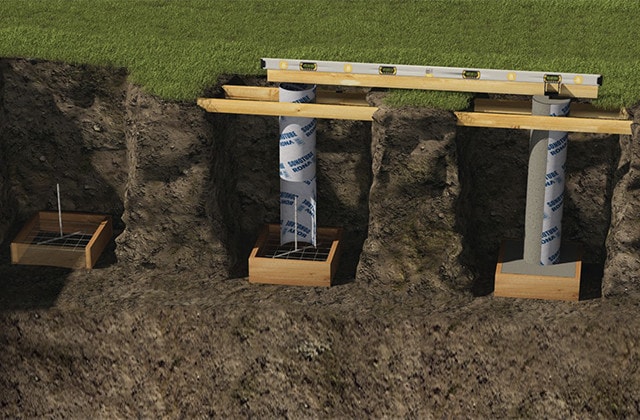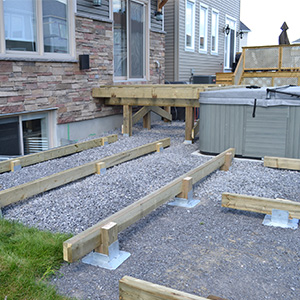From Idea to Concrete: The Critical Duty of Deck Footings in Sturdy and Safe Decks
Wiki Article
Selecting the Right Deck Footings for Security and Durability
When it involves constructing a deck, one of one of the most critical choices you will certainly make is selecting the best footings for stability and resilience. The longevity and safety of your deck depend greatly on the kind of grounds you choose, as they offer the essential support and security to hold up against the test of time. With a myriad of choices available, it can be frustrating to determine which grounds are best fit for your certain needs. In this discussion, we will certainly explore the numerous sorts of deck footings, consider the important aspects to consider when choosing, and dig into the advantages and disadvantages of various options. By the end, you will certainly have a more clear understanding of the selections handy and be much better equipped to make a notified decision for your deck task.Kinds Of Deck Footings
There are numerous kinds of deck grounds that can be utilized, each offering unique advantages and considerations. One common type of ground is the concrete pier footing. These footings are composed of a cylindrical opening loaded with concrete, which provides a strong structure for the deck messages. Concrete pier footings are reasonably easy to mount and supply excellent security, making them a popular choice for several deck projects.These grounds are set up by screwing them into the ground, which develops a safe and secure structure for the deck. They also allow for simple change and progressing of the deck if required.
Alternatively, some building contractors select precast concrete footings. These footings are constructed from durable concrete and can be found in numerous shapes and sizes to suit different deck designs. Precast concrete footings are practical to install and give a secure base for the deck structure.
Ultimately, another option is the post-in-anchor ground system. This kind of footing involves driving a steel support right into the ground and connecting it to the deck message. It offers versatility in terms of placing the deck posts and appropriates for decks with light-weight structures.
When choosing the ideal kind of deck footing, it is essential to think about elements such as soil problems, deck lots, and regional building regulations (Deck Footings). Consulting with a professional service provider or structural engineer can assist make sure the ideal footing is picked for a risk-free and secure deck
Factors to Think About When Picking Footings
When selecting the suitable footings for a deck, it is essential to thoroughly take into consideration various elements such as soil problems, deck load, and adherence to regional building codes. These variables play a significant function in guaranteeing the stability and toughness of the deck framework.The kind of dirt on which the deck will be constructed establishes the type of grounds needed. On the other hand, decks built on clay or large soils may need grounds that can suit the dirt's tendency to expand and contract.
Another crucial factor is the deck tons. The weight of the deck, consisting of the materials made use of and any type of potential real-time loads such as furniture or celebrations, must be considered when picking footings. The footings must be developed to bear the weight of the deck and distribute it uniformly to avoid any structural concerns or failures.
Last but not least, adherence to local building ordinance is critical. Building regulations vary from region to area, and it is see post vital to follow the my sources specific needs established by the local authorities. Deck Footings. These codes ensure that the deck is built safely and meets the essential requirements for architectural integrity and load-bearing capacity
Concrete Footings: Cons and pros

When utilized as the structure for a deck,Concrete footings offer a number of benefits and downsides. On the favorable side, concrete grounds provide excellent security and longevity. Concrete is a inflexible and strong material that can support hefty tons and stand up to numerous weather problems. It likewise has a lengthy life expectancy, making it a trusted option for long-term usage.
An additional advantage of concrete footings is their versatility. They can be put into various sizes and shapes to accommodate various deck styles and configurations. Concrete grounds can be personalized to fit the details requirements and requirements of the deck framework.
Nevertheless, there are also some downsides to making use of concrete grounds. One major negative aspect is the cost and labor associated with their installment. Concrete grounds call for excavation and usually require the assistance of heavy equipment. This can raise the general cost of the deck project and may need expert support.

Helical Piers Vs. Sonotubes: Which Is Much better?
In thinking about the foundation alternatives for a deck, the contrast between helical piers and sonotubes is important in determining the exceptional option. Helical piers, likewise called screw heaps, are steel shafts with helical plates connected to them. They are turned into the ground using hydraulic equipment, providing a long lasting and steady foundation for the deck. explanation On the other hand, sonotubes are cylindrical forms made of cardboard or fiber product that are loaded with concrete. They are positioned in an opening dug into the ground and offer support for the deck.When it comes to security and longevity, helical piers have the top hand. The helical plates on the piers create a solid grip with the dirt, moving or stopping any kind of movement of the deck. This is especially beneficial in areas with unstable or moving soil conditions. Sonotubes, on the other hand, count only on the concrete filling up for stability, which may not supply the same degree of stamina and resistance.
In terms of installment, helical piers are fairly less complicated and faster to install compared to sonotubes. The hydraulic machinery utilized to twist the piers into the ground makes certain a reliable and quick procedure. Sonotubes, on the various other hand, require excavating openings and putting concrete, which can be time-consuming and labor-intensive.
In addition, helical piers are an even more flexible option. If needed, they can be made use of in numerous soil problems and can be adjusted or strengthened. Sonotubes, on the other hand, might require added assistance, such as rebar, in specific dirt conditions or areas with high load demands.
Choosing the Right Footings for Your Deck's Dimensions
For optimum structural honesty, it is important to carefully choose the suitable footings that straighten with the dimensions of your deck. The dimensions of your deck, including its size, length, and elevation, play a considerable duty in identifying the type and dimension of footings called for.When selecting footings for your deck, it is essential to think about the load-bearing capability of the soil. The weight of the deck, incorporated with the weight of any furniture or individuals on it, puts in a significant pressure on the footings (Deck Footings). For that reason, it is essential to choose grounds that can appropriately sustain this weight without moving or sinking over time.
Bigger decks with better dimensions need larger grounds to provide enough stability and assistance. The form of the grounds, whether they are square or round, depends on the design and design of the deck.
Verdict
To conclude, choosing the best deck grounds is important for ensuring stability and resilience. Variables such as the kind of footings, the deck's measurements, and the pros and disadvantages of different options should be considered. Concrete grounds supply strength and durability, yet might be much more expensive and lengthy to set up. Helical piers and sonotubes have their very own advantages and disadvantages. Eventually, selecting the proper grounds for your deck's specific demands is vital for a lasting and successful framework.These grounds are composed of a round hole loaded with concrete, which gives a solid foundation for the deck posts. Concrete pier footings are relatively simple to install and use exceptional stability, making them a prominent selection for numerous deck projects.
Precast concrete grounds are convenient to mount and supply a steady base for the deck structure.
It uses adaptability in terms of placing the deck blog posts and is appropriate for decks with lightweight structures.
Concrete grounds offer several advantages and negative aspects when used as the structure for a deck.
Report this wiki page